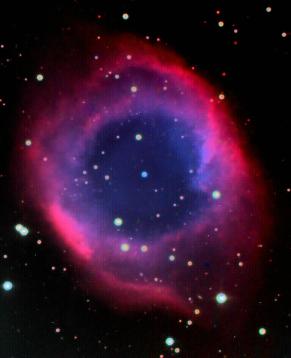Planetary Nebulae - dying stars
Ruben's Nebulae - Part 1
Emission Nebulae - the birthplace of stars




Planetary Nebulae M57 (the Dumbbell) and the Helix, ST1001
camera, 14" SC reflector, New Mexico, total exposure times 43
minutes.
camera, 14" SC reflector, New Mexico, total exposure times 43
minutes.
Cocoon Nebula and Bubble Nebula, ST1001 camera, 14" SC reflector,
New Mexico, total exposure times 43 minutes.
New Mexico, total exposure times 43 minutes.
The Helix Nebula, in the constellation Aquarius,
is another dying star that has blown off its outer
layers, once its central supply of hydrogen is
nearly exhausted. The remnant central star is a
dense "white dwarf" that can no longer support
nuclear reactions. At a distance of 450 light
years, it is the closest planetary nebula to earth.
The very hot white dwarf ionizes an inner shell
of oxygen, which appears blue in this image, and
an outer shell of hydrogen, which appears red.
is another dying star that has blown off its outer
layers, once its central supply of hydrogen is
nearly exhausted. The remnant central star is a
dense "white dwarf" that can no longer support
nuclear reactions. At a distance of 450 light
years, it is the closest planetary nebula to earth.
The very hot white dwarf ionizes an inner shell
of oxygen, which appears blue in this image, and
an outer shell of hydrogen, which appears red.
At a distance of 11,300 light years in the
constellation Cassiopeia, the Bubble Nebula
combines symmetry with irregularity. The nebula
is composed of a huge cloud of mostly hydrogen
gas measuring 10 light-years across, more than
twice the distance of the earth to the nearest star.
This gas cloud is being disrupted by a massive
bright star emitting a powerful "stellar wind..�
This fierce wind displaces the surrounding nebula
gas into a shell, which is then ionized by the
energetic starlight, causing both the spectacular
shell and surrounding nebula to glow!
constellation Cassiopeia, the Bubble Nebula
combines symmetry with irregularity. The nebula
is composed of a huge cloud of mostly hydrogen
gas measuring 10 light-years across, more than
twice the distance of the earth to the nearest star.
This gas cloud is being disrupted by a massive
bright star emitting a powerful "stellar wind..�
This fierce wind displaces the surrounding nebula
gas into a shell, which is then ionized by the
energetic starlight, causing both the spectacular
shell and surrounding nebula to glow!
The Cocoon Nebula is a birthplace of new
young stars, allowing it to be classified as a â
€œstellar nursery.â€� A cluster of young
stars within the Cocoon have recently evolved
out of a large molecular gas cloud, with both
the stars and cloud made up mostly of
hydrogen. In the center of the Cocoon nebula,
a massive “newborn� star emerged
about 100,000 years ago, opening a hole within
the molecular cloud. The central star provides
the energy source that excites the surrounding
gas to a glowing red. The nebula is located
4000 light years away in the constellation
Cygnus.
young stars, allowing it to be classified as a â
€œstellar nursery.â€� A cluster of young
stars within the Cocoon have recently evolved
out of a large molecular gas cloud, with both
the stars and cloud made up mostly of
hydrogen. In the center of the Cocoon nebula,
a massive “newborn� star emerged
about 100,000 years ago, opening a hole within
the molecular cloud. The central star provides
the energy source that excites the surrounding
gas to a glowing red. The nebula is located
4000 light years away in the constellation
Cygnus.
The "Dumbbell Nebula" is the remnant
of a star that has gone Nova, blowing
off its outer shell of gas. These types of
objects were termed "planetary nebula"
over 200 years ago because they
resembled dim planets through the
telescopes of that time. The Dumbbell is
1200 light years distant.
of a star that has gone Nova, blowing
off its outer shell of gas. These types of
objects were termed "planetary nebula"
over 200 years ago because they
resembled dim planets through the
telescopes of that time. The Dumbbell is
1200 light years distant.
Music: Stairway to Heaven by Led Zeplin